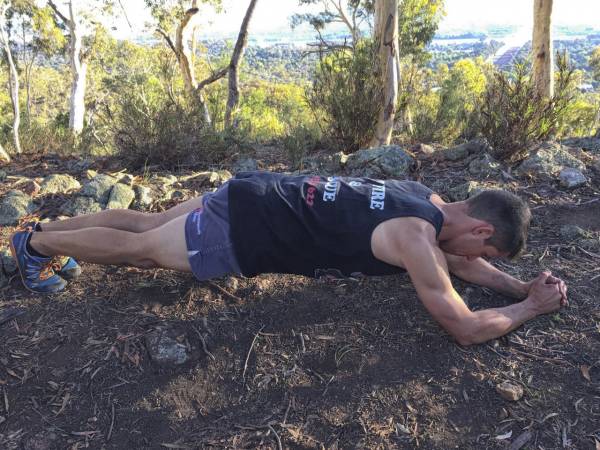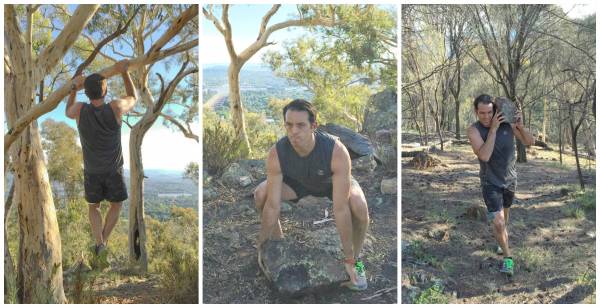Due to the pervasive nature of fitness infomercials, I’d be willing to bet that nearly everyone has heard that classic tagline “You gotta door? You gotta gym!” While the product behind that tagline is questionable, I always liked the minimal training concept of the words themselves.
But what if I live in a cave, Jake?
With that tagline in mind, this article is going to provide you with a more realistic and effective spin on the concept. Thanks to a bit of imagination, I’ve discovered that if you’ve got the outdoors, you’ve gotta gym! Read on for a guide on setting up your own outdoor gym along with a workout to try.
Where Is the Best Place for an Outdoor Gym?
Practically anywhere! Although it depends on what you want to do and your access to the outdoors. I am currently based in Australia’s capital city, Canberra, in the Australian Capital Territory (ACT). One of the best and most unique things about Canberra is the abundance of open outdoor space and closeness to bushland. For example, my training partner, ACT Fire Brigade Officer Dave Bremers, and I discovered Mount Ainslie is a mere ten minute’s jogging distance from us and has an abundance of natural objects and trails we can utilize. What’s near you?
A kangaroo training partner is optional.
What Objects Work Well in an Outdoor Gym?
Any natural objects that you can lift, carry, climb, or pull yourself up from. Try for a variety of different sized rocks or log to lift or carry and low tree branches for pulling exercises or climbing. In addition, look for trails, paths, and hills for weighted carries.
How Do I Program for Outdoor Gym Sessions?
While you are only limited by your imagination and what objects you have access to, I recommend keeping it simple and focusing on full-body style workouts. I have found the following template works well:
- Lower body movement (quad dominant) – Log or rock squat variations
- Upper body pulling movement – Tree chin up or pull up, or tree inverted rows
- Lower body movement (hip dominant) – Log or rock deadlift variations
- Upper body pushing movement – Push ups, Log or rock bench-style presses
- Whole body explosive and/or whole body grind – Rock or log carries and/or rock or log throws
- Core work – Plank or back extension variations

The RKC plank is an excellent way to develop core strength and full-body tension.
Exercise-wise, you are only limited by your imagination and the objects around you. If your outdoor setting doesn’t have rocks, logs, or other objects for loaded exercises, simply focus on bodyweight movements with increased difficulty and/or more repetitions. Be prepared to be flexible and adapt your workout to best suit your surroundings and to ensure you have fun.
What Are the Benefits of an Outdoor Gym?
Training outdoors is an enjoyable and fun change to being in the often sterile and artificial environment of a gym. Lifting and playing with randomly sized and weighted outdoor objects is a fantastic challenge to grip strength and endurance, while their offset loads and holds help improve coordination and strengthen often-neglected stabilizer muscles.
“While you are only limited by your imagination and what objects you have access to, I recommend keeping it simple and focusing on full-body style workouts.”
I hate to use that word “functional,” but getting better at picking up and moving large awkward objects like logs and rocks is pretty functional training for everyday life. Getting to train in the outdoors, particularly in my country of Australia, also means getting a good dose of sunshine and the associated vitamin D benefits. There is also just something cool about having kangaroos and other Australian wildlife in your “gym” watching your form!
Your Outdoor Workout: “Bremers”
Here is my current go-to outdoor gym workout that you can get started with. It’s 45 to 60 minutes of full-body training that works great as a solo session or when done with a partner.
“Bremers”
- Rock squat thruster – ascending ladder, up only – max 10 reps
- Tree chin up (alternating grip) – ascending ladder, up and down
- Rock sumo style deadlift – ascending ladder, up only – max 10 reps
- Push ups – ascending ladder, up only – max 10 reps
- Rock carry – 2 x 3 minutes, maximum efforts for distance
- RKC plank – 3 x maximum efforts for time

No loud music, no waiting for equipment – just me, the outdoors, and a fun workout.
Notes:
- Ascending ladder, up only: Do 1 rep, rest 15 seconds, do 2 reps, rest, do 3 reps etc. Continue in this fashion until you fail a set and/or until you complete the 10-rep set.
- Ascending ladder, up and down: Do 1 rep, rest 15 seconds, do 2 reps, rest, do 3 reps etc. Continue in this fashion until you struggle to complete a set and then return back to 1 rep. You then continue going up until you are 1 rep short of where you stopped previously, then you return to 1 rep. Said another way: if on your first effort you get 1, 2, 3, 4, and then 5 reps. Then the next round you start back at 1 rep and work up to 4. After completing 4 reps, you start back at 1 rep and work up to 3. Continue up the ladder, going one rung less each time until you are too fatigued to even complete 1 rep.
Give it a try and let me know how you go. Remember, you got the outdoors, you gotta gym!
Check out these related articles:
- How to Create a Better Workout Training Plan Than Anyone Else
- How and Why to Run Hill Sprint Intervals
- Primal Fitness – What It is and Why It is Important
- What’s New On Pulse Beat Fit Today






